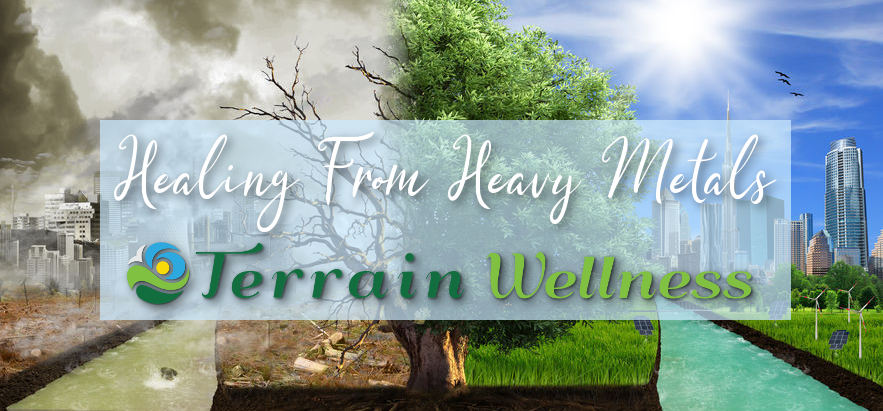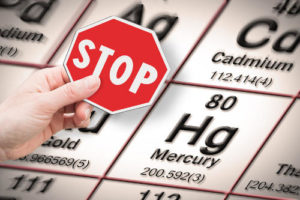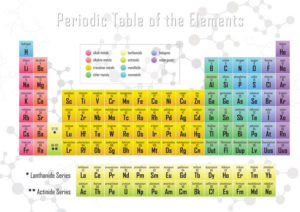What are heavy metals?
“Toxic heavy metals” refer to dense metals and metalloids on the periodic table that are poisonous to humans and animals. The term “heavy metals” has come into common use because naturally occurring elements like lead, cadmium and mercury are both dense (aka “heavy”) and toxic. That said, some lighter elements such as aluminum have also been found to be toxic and are sometimes included in lists of toxic heavy metals; this makes the term “heavy metals” a bit imprecise. Despite their toxicity, these metals have other properties that make them popular for many industrial applications, meaning that our chances of exposure have increased exponentially since the industrial revolution.
See our other article for how heavy metals affect thyroid function.

Toxic metals include lead, arsenic, mercury, cadmium, aluminum, thallium and others. While heavy metals can be found naturally in very small amounts, human activities like agriculture, mining and manufacturing have brought these toxins up to the surface in unnaturally concentrated amounts. Products such as batteries, fertilizers, pesticides, paints, household products and building materials can contain heavy metals. The treatment for toxic heavy metal poisoning is Chelation & IV Therapy, a complex medical process involving multiple visits and close medical supervision.
Heavy metal toxicity can be particularly insidious because the body has difficulty metabolizing and eliminating these substances. Being so toxic to the body, the body cannot allow heavy metals to circulate in the bloodstream. The liver detoxification pathways and kidneys can eliminate small amounts toxic metals. But, when the liver is overwhelmed by too many toxic substances, the body protects itself by storing them in bones, organs and fat cells. Storage isn’t a permanent solution though, because heavy metals building up damages our vital organs. In some cases, toxic metal exposure in the past may come back to haunt us when those substances are released back into the bloodstream, causing systemic health problems. For instance, the body tends to store lead/mercury in the bones; as we age and lose bone mass, these harmful elements re-enter the bloodstream.
Why be concerned about heavy metal poisoning?

Acute heavy metal poisoning is rare, but chronic accumulation of heavy metals is becoming more common. Although the slow accumulation of toxic heavy metals may go unnoticed for some time, the long-term health issues that come with it are quite serious. Heavy metals building up in the body may manifest in many ways. Unexplained chronic health conditions that do not improve despite treatment, bizarre neurological symptoms and thyroid or other endocrine dysfunction may be caused by undetected toxic metal exposure. Heavy metals disrupt critical body systems including the brain, heart, liver, kidneys, lungs, skin, immune system, endocrine system and gut. These substances have also been linked to cancer, fertility issues, sexual dysfunction and cognitive decline.
Heavy metal exposure is also particularly harmful to the thyroid. Factors like autoimmune thyroid issues, decreased T3/T4 and thyroid cancer among many other problems have been associated with heavy metals. For this reason, we routinely look for signs of heavy metal exposure as part of our thyroid treatments in our practice of naturopathic primary care medicine.
Effects of toxic heavy metal exposure
| Toxic Metal | Acute Exposure | Chronic Exposure |
|---|---|---|
| Lead (Pb) | Brain dysfunction (confusion, seizures, inflammation, numbness/tingling, etc), nausea and vomiting, abdominal pain. | IQ drop in children, neurological issues/cognitive decline (such as trouble with memory, hand-eye coordination, language recall), behavioral issues, anemia, abdominal pain. |
| Mercury (Hg) | Loss of peripheral vision and other sensory changes, loss of muscle coordination, burning or itching pain. | Muscle weakness, sensitivity to light, kidney/brain/liver dysfunction, profuse sweating, high blood pressure, skin breakdown. |
| Arsenic (As) | Vomiting, abdominal pain, bloody diarrhea, brain dysfunction | Skin issues, bladder/lung/liver cancer, high blood pressure, Type II diabetes, cardiovascular disease, chronic viral infections (esp varicella zoster). |
Heavy Metal Poisoning & Biological Magnification
The most common routes of toxic heavy metal exposure are contaminated food, water or air. While eating plants containing heavy metals can lead to exposure, eating meat from animals/fish that feed on contaminated food sources can lead to concentrated exposure.
Biological magnification (biomagnification) is the process where toxins like heavy metals become more concentrated as one moves up the food-chain. Plants and microscopic organisms at the bottom of the food chain have the lowest concentration of toxic metals. However, each step up the food chain increases the concentration of toxic metals. For example, microscopic plankton retain toxic metals just like other living organisms. However, since plankton are very small and have short lives, they do not end up with high levels of toxins. Moving up one level on the food chain: a sardine eats millions of plankton over its life and retains toxic metals from every plankton eaten. In this way, the sardine ends up concentrating the heavy metals from millions of plankton into its body tissues over its lifetime. Moving up a second level on the food chain: a tuna eats thousands of sardines and retains the heavy metals from every sardine it eats. In this biomagnification process, the tuna ends up two levels of concentration higher in toxic metals than plankton. Moving up to the top of the food chain: a person eats tuna on a regular basis, exposing themselves to the toxic metals found in countless plankton and sardines all concentrated down into each serving tuna. Here is another article that explains heavy metals testing.
A few sources of toxic heavy metals:
Source: FDA Total Diet Study on Toxic & Nutritional Elements.
| Toxic Heavy Metal: | Food Sources: | Environmental Sources: |
|---|---|---|
| Lead (Pb) | Canned fruits (pineapple, peach, pear) and water. | Leaded paint, dinnerware, untested herbal remedies, PVC products, water pipes. |
| Mercury (Hg) | Tuna (all species), swordfish, king mackerel, groupers, white croakers, halibut, seafood in general. | Mercury amalgams and dental waste, volcano eruptions, oil well fires, crematoriums. |
| Arsenic (As) | Rice, shrimp, salmon steaks, canned tuna, raw mushrooms, fast-food chicken. | Drinking water (especially well water), cigarettes. |
| Cadmium (Cd) | Sunflower seeds, American cheese, pork bacon, cow liver, (frozen) fish sticks, peanuts and peanut butter, shredded wheat cereal, avocado, soy. | Fossil fuels, medical waste, fertilizers, smelters, tobacco smoke, batteries, plastic stabilizer, some jewelry, paint. |
- mining
- conventional farming
- crematoriums
- dental offices
- automotive repair/manufacturing
- industrial construction
- welding
- battery manufacturing
- ceramic or pottery production
- plastic & rubber manufacturing
Factors that increase risk of toxic heavy metal exposure
Working in (or living nearby) the following industries may increase toxic metal exposure risk:
Seeking treatment for heavy metal exposure

If you feel like you may have unhealthy levels of heavy metals in your body, it is important to seek competent medical care. When you do seek medical care, there are a few points to keep in mind regarding lab test results. The first point is that lab tests for heavy metals can be misleading because many labs only flag test results that are in the top 75th percentile of their test results. This is problematic because a “normal” range according to the laboratory may be well outside of CDC guidelines for heavy metals. The second issue with percentiles on lab tests is that people who get tested suspect a problem and are not a neutral population sample. This skews results by raising the average exposure level from which a “normal, acceptable” range is determined.
At Terrain Wellness, we take the above factors into account when we review labs and develop our treatments. As doctors specializing in treating the thyroid, we understand that thyroid health may be affected by past heavy metal exposure. Rather than a one-size-fits-all approach, we understand that each person may respond a bit differently and this is why we practice individualized naturopathic primary care. For some patients with high levels of toxic heavy metals, we will prescribe and administer IV chelation therapy. However, it’s important to realize that chelation therapy is a complicated process requiring close medical supervision involving multiple visits and repeated lab tests. Although IV chelation therapy might not be right for everyone, the National Institute of Health considers it the preferred treatment for eliminating toxic heavy metals from the body.
Yours in health,
Terrain Wellness
Thanks for reading. We hope you found this article helpful. If you’d like to read more articles like this one or follow along with our summer, 2019 thyroid series, sign up below if you haven’t already.


